
“The risks of a prolongation of the short squeeze look high,” said Roberto Cobo Garcia, head of G-10 FX strategy at BBVA in Madrid. “With the BOE poised to cut sooner than expected, and with stretched positioning and valuations, the trend may have started to revert.”
The pound’s drop also boosted demand for options that pay out if the currency falls. So-called risk reversals – a barometer of market positioning that compares the demand to buy a currency versus the appetite to sell – now show the most bearish sentiment for sterling since late October.
It all comes as traders increased bets the BOE will deliver its first quarter-point cut in June, as two of the most hawkish members dropped their calls for rate hikes on last week’s decision that left rates steady at 5.25 per cent. That means the UK would move in lockstep with the US Federal Reserve and the European Central Bank, which are also seen cutting for the first time on that month.
Earlier this year, expectations were that euro-area and US policymakers would act sooner and deliver more cuts. Now, the amount of easing priced in for the BoE – about 80 basis points – is widely in line with what’s seen coming from the Fed. Bets are slightly more aggressive for the ECB, at around 90 basis points.
“This is a clear shift in tone, and it will make people more cautious about the UK rate outlook being that different than other central banks,” said Dominic Bunning, head of European FX research at HSBC. “It takes juice out of the pound.”
Mr Bunning expects the pound to fall to $US1.20 in the second half of the year, when the BoE starts to cut rates. On Friday, it traded at $US1.26, down 1.1 per cent on the week.
Neil Mehta, a portfolio manager at RBC Bluebay Asset Management, lists other risks to the pound this year, including the prospect of a change in the UK government following a vote expected later in the year.
“The combination of political uncertainty in the UK and the risk of a stagflationary environment in the second half this year will be negative for the pound,” said Mr Mehta, adding that he expects sterling to fall towards $US1.15 in the second half of the year.
Bloomberg
Bloomberg



